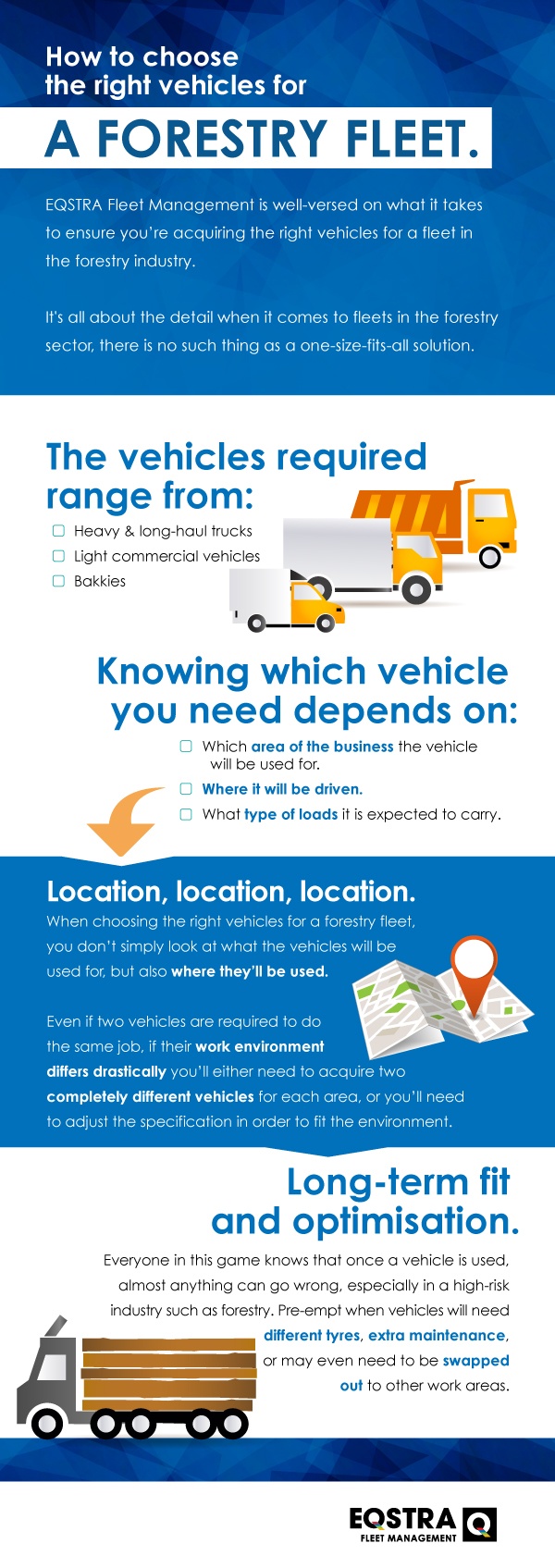 Specialised fleets require vehicles that are a perfect fit for their specific job – fleet managers must have a keen understanding of all fleet requirements to ensure they make the right choice.
Specialised fleets require vehicles that are a perfect fit for their specific job – fleet managers must have a keen understanding of all fleet requirements to ensure they make the right choice.
With Sappi Southern Africa as one of our clients, EQSTRA is well-versed on what it takes to ensure you’re acquiring the right vehicles for a fleet in the forestry industry.
“When it comes to such specialised fleets we work closely with the client and vehicle manufacturer to help ensure all fleet needs are met,” says Saga Govender, Technical Manager Operations at EQSTRA Fleet Management.
Sappi is well-established and, as such, they have existing relationships (and preferences) when it comes to vehicle manufacturers. “In most cases, big clients like this company will conduct the exercise of sourcing the vehicles themselves and we will help with the procurement process”, says Saga, “Sappi will choose vehicles per set specifications based on the set application and we will advise based on expertise if those vehicles would be appropriate for the application.”
As Sappi's fleet management partner, it is up to EQSTRA to research all vehicles chosen by them, as well as any alternatives. EQSTRA stays on top of all developments in the vehicle industry, including legislation, and works closely with companies to ensure every vehicle in the fleet is fit for purpose.
It's all about the detail
When it comes to fleets in the forestry sector, there is no such thing as a one-size-fits-all solution.
The vehicles required range from:
- heavy and long-haul trucks
- light commercial vehicles
- bakkies.
Knowing which vehicle you needs depends on:
- which area of the business the vehicle will be used for
- where it will be driven
- what type of loads it is expected to carry.
It’s up to EQSTRA to lend their expertise in all of these areas to help the client spec and source the correct vehicle.
According to Saga, the most important question is: What will the application of the vehicle be? Once you have this information, you can start looking at what specification is required and the type of tyres that will be required.
Location, location, location
When choosing the right vehicles for a forestry fleet you don’t simply look at what the vehicles will be used for, but also where they’ll be used.
Forests differ in terrain so a forest in northern KZN would require floatation as the terrain is mainly made up of soft sand. A vehicle operating in the Natal Midlands, on the other hand, will face a terrain of shell rock. Therefore, even if two vehicles are required to do the same job, if their work environment differs drastically you’ll either need to acquire two completely different vehicles for each area, or you’ll need to adjust the specification in order to fit the environment.
Long-term fit and optimisation
“Choosing the right vehicles is actually the easiest part”, says Saga “meticulous fleet maintenance and management in the long run is what makes the difference in keeping your forestry fleet running at optimal efficiency.”
It is at this stage – once all the vehicles have been procured – that EQSTRA focuses on building and maintaining an excellent relationship between themselves, the company, and the relevant vehicle manufacturers. Everyone in this game knows that once a vehicle is use, almost anything can go wrong, especially in a high-risk industry such as forestry. EQSTRA’s role is to ensure that all vehicles are used and maintained according to manufacturer guidelines which is the best way to minimise the risk of accidents / vehicle failure.
“At EQSTRA we pay close attention to detail, but also keep an eye on the bigger picture”, says Saga. Factors such as changing conditions at different work sites means we need to pre-empt when vehicles will need different tyres, extra maintenance, or may even need to be swapped out to other work areas in the company's network. This is all part of sustaining the vehicles and keeping the fleet running smoothly.
As an experienced fleet management company, EQSTRA also continuously looks for new vehicle developments and technology that will benefit their client. Says Saga, “We’re always looking for ways to optimise and reduce costs.”

